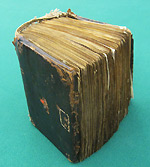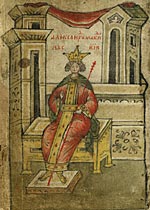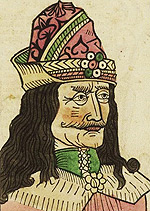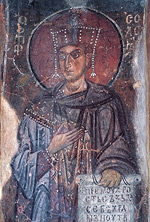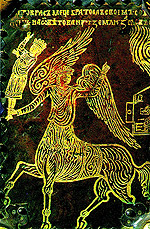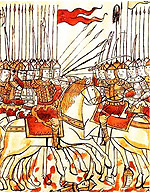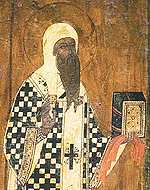Euphrosynus Literary Heritage
The Euphrosynus manuscripts are very interesting for their content. These are lovingly selected books of a personal monastic library, intended for private reading.
Books and Reading in Old Russia
Our ancestors enjoyed reading the books and valued them. A book was a key attribute of worship. The Gospel used during religious services was kept on the Holy Table (altar) and was considered to be sacred. But in ancient Rus' along with religious books, there were copied works that were designed specifically for reading. The earliest surviving books for reading are Miscellanies of 1073 and 1076. They contain an expression that states, 'It is useful and good to respect books'. The selection of books intended to be a reading was diverse, but strictly regulated. Until the 15th century, books in Russia were handwritten on parchment (treated animal skins). Books were very expensive, so scribes copied only important texts: the Bible, the writings of the Church Fathers, lives of saints, the official historical stories. Any text - liturgical or literary - existed in the form of a number of handwritten copies, each of which could become a model for the creation of the following copy. Thus, the manuscript tradition of the text evolved.The readings were primarily edifying, "useful for the soul". Not by chance that in the ancient, pre-Mongolian time, in Russia there were «Indices of forbidden books» - lists of prohibited works. Those included the Biblical apocrypha (non-canonical writings related to the Old or New Testament, but not authorized by the church), fortune-telling texts, all kinds of "tales", i.e. the "entertaining" narratives. Despite the bans, ancient scribes were keen on such fiction stories and incorporated them into books for reading. Many miscellanies have survived, they were composed not only of religious, hagiographic and didactic works but also of secular writings. The secular works told stories, often in an question-answer form or a form of riddles, sometimes using oral histories and narratives of distant historical events in distant lands, in which real historical persons turned into literary heroes.
The Euphrosynus manuscripts are miscellanies for reading. Euphrosynus knew «Indices of forbidden books» very well. He rewrote it several times (Kir.-Bel. 22/1099, fol. 39v., fol. 40v., fol. 302v.; Kir.-Bel. 53/1130, fol. 548, fol. 550). But, in addition to religious works, the Euphrosynus miscellanies embrace many entertaining and educational texts for his own personal reading. The monk-scribe's interests were so encyclopedic that his manuscripts are considered to be a Renaissance phenomenon.
Anthology of the Fifteenth-century Secular Literature
Indeed, the main features of Renaissance culture were its secular character and a sense of the significance of the individual within society and in the art. During the Renaissance period, European art began to move away from the Church's control. In the fifteenth-century Russia, the separation of culture from religious influence did not take place. But judging by surviving handwritten books, Old Russian manuscripts of that time included increasingly large "useless" works such as translated pieces of fiction as well as literary forms of folk stories that before had existed only in oral. This was facilitated by growing use of a new, cheaper writing material - paper, spread in Russia during the 15th century.
The Euphrosynus miscellanies are a kind of anthology of secular literature known in Russia in the 15th century. It turns out that these manuscripts include the oldest copies of many works. The Euphrosynus heritage also brightly reflects his individual way of thinking, which manifested itself not only through the interests of the compiler, but also through the free way in which Euphrosynus edited texts. As a rule, he shortened the text by removing didactic passages, but without losing the sense. Euphrosynus also inserted his own comments throughout the text, made additions to the different parts of the story, that interested him. Rewriting the texts, Euphrosynus gave his own interpretation of them. So he created original versions of works.
A complete list of all texts contained in each of the Euphrosynus manuscripts, is presented in section Contents. It consists of several hundred works of different size on a variety of subjects and themes. This includes numerous brief extracts copied in Euphrosynus' hand from various works. Information concerning the scientific identification of most texts are given in a monographic study: Kagan M. D., Ponyrko N. V., Rozhdestvenskaja M. V. Opisanie sbornikov XV v. knigopisca Efrosina // Trudy Otdela drevnerusskoj literatury Instituta russkoj literatury AN SSSR (Pushkinskij Dom). T. 35. Rukopisnoe nasledie Drevnej Rusi. L., 1980. S. 3 ― 300.
It is impossible to tell about all the works contined in the Euphrosynus manuscripts in a brief review. So we will dwell only on the most important and interesting.
Alexander Romance
Let us start with the "thickest" novel which mostly strongly impressed Euphrosynus who rewrote the landmark in several editions. This is the Alexander Romance ― the Greek text concerning the life and deeds of the Alexander the Great of Macedonia (356-323 BC). The story was composed on the basis of the Alexander legends and tales. It was attributed to the historian Callisthenes, a great nephew of Aristotle, who accompanied Alexander the Great on his campaign and chronicled his conquests. However, the real author of the legendary material is unknown but is still labeled Pseudo-Callisthenes. The text was recast into various versions in European and Easten countries. In Russia, the history of the Alexander the Great was translared in the 12th-13th centuries and became a part of Old Russian historical book - the Chronicle of the Greeks and the Romans. This version of the Alexander Romance is called "chronological" (Kir.-Bel. 9/1086, fol. 474). A South Slavic translation of the history of the Alexander under the title Serbian Alexander Romance came into Russia from Serbia during the 15th century. It is a fiction rather than a historical document, most of the content of the Romance is historically inaccurate, including many fantastical episodes and encounters with monstrous peoples and mythical creatures. The Serbian Romance tells the story of the Last Judgment and the expedition of Alexander to the Paradise on earth. This Christian revision of the Greek novel has been preserved in a variety of Russian copies of the 17th-19th centuries.
But only one fifteenth-century Russian copy of the Serbian Romance has survived in the Euphrosynus manuscript (Kir.-Bel. 11/1088, fol. 20). Should be noted that it is an original redaction of the text because Euphrosynus has made many changes in it. This revised version of the Serbian Romance was published in the series «Literary Monuments» in 1965.At the end of the Serbian Alexander Romance, Euphrosynus has placed a timeline that shows key historcal dates and events from Alexander the Great to Jesus Christ (Kir.-Bel. 11/1088, fol. 194). Euphrosynus' revision embraces rare episodes: how Alexander was carried into the air by the gryphons (Kir.-Bel. 11/1088, fol. 502), about the daughter of Alexander Panora (Kir.-Bel. 22/1099, fol. 505-506) [*]. The latter story has a second title - the Legend of the Origin of Mermaids. The number of copies in which the legend has been survived does not exceed ten. All they are South Slavic and are stored in libraries of different cities of the world - in Sofia, Copenhagen, Vienna, Belgrade. The Euphrosynus version is the only Russian copy, it is earlier than all the other survivers. The Russian text reflects features of the older language of the 13th-14th centuries - Middle Bulgarian, Euphrosynus apparently used a very old South Slavic manuscript. At that, Euphrosynus amended the text, making it more understandable for the Russian reader, ― he omitted unclear passages or inserted explanatory additions, explaining difficult passages.
The legend develops the theme of immortality. The Greek version of the Alexander Romance tells the story about the cook, who found the elixir of life, and gave it to the daughter of Alexandr to drink. She and the cook got immortality. Thrown into the water by the order of Alexander, they turned into a sea demon and a mermaid. In the Serbian Romance, the story is presented in a different way. Once in the camp, Alexander's cook washed dried fish in the waters of a lake, - the fish returned to life and swam away. The Euphrosynus interpretation is complemented with another dramatic episode borrowed him from Bulgarian literature - about loyalty of a boy who was seduced by the daughter of Alexander and then died. There appeared a new version of the story.
The main theme of the story is the desire of Alexander the Great to achieve immortality and, thus, avoid early death predicted to him. Euphrosynus was excited by the fate of the extraordinarily gifted hero, who still could not escape the laws of nature. No coincidence, he ordered to the icon-painter Ephraim Trebes the miniature depicting Alexander the Great for his manuscript. Euphrosynus was also particularly attracted by the story about Alexander's journey to the country of sages.
Alexander and Sages
The «Tale of Rahmans (Brahmans) and their Wonderful Life»is an outstanding Old Russian landmark of a social utopia. The largest portion of the text was drawn from the 9th-century Greek Chronicle of George Hamartolos, to which it came from Palladius' work translated in Russia and included also in the "chronological" Alexander Romance. The Euphrosynus miscellanies embrace all versions ― the Palladius work, and the Serbian Romance with a legend of Brahmans, and the "chronological" Alexander Romance, and Hamartolos' Tale as an individual item. They are supplied with unique additions which are associaited with utopian ideas circulated among the Russian clerics. For instance, Euphrosynus so describes the people, 'the Brahmans has no king, no nobles. Brahmans do not fear death - they are opposed to Alexander seeking to escape from the death.
As a separate work, the Tale of Brahmans has been preserved only in the Euphrosynus manuscript (Kir.-Bel. 11/1088, fol. 483-485v.). In the postscript to the story of Brahmans, Euphrosynus stated that Brahmans 'live near the Paradise'.
The Tale of Brahmans is not the only evidence of Euphrosynus' interest in utopian ideas. He copied also the Legend of the Indian Kingdom ― a legendary proposition of the devout king on the blissful Indian country (Kir.-Bel. 11/1088, fol. 198-204), as well as celebrated Letter on the Paradise written by Archbishop of Novgorod the Great Vasilii Kalika to Bishop Fedor of Tver' (Kir.-Bel. 22/1099, fol. 239-244).
No less attention is given in the Euphrosynus manuscripts to the theme of Apocalypse. The scribe transcribed Apocalypse for Father Superior Ignatius (Kir.-Bel. 53/1130, fol. 130-155v.)and inserted in another miscellany Tale about the End of the World and the Antichrist by Hippolytus, Pope of Rome (Kir.-Bel. 22/1099, fol. 446-475). Fol. 463 bears Euphrosynus' note about the mark of Antichrist). The Euphrosynus manuscripts also contain the special essay About Seven Thousand Hours (Kir.-Bel. 22/1099, fol. 372v.), an extract from Dioptra that narrates a dispute between the body and the soul. It was a work by the 11th century Byzantine monk Philipp the Hermit.. Euphrosynus also copied some apocrypha concerning the end of the world: Tale of the Week (Kir.-Bel. 11/1088, fol. 254-261), Dreams of King Shahnaishi (Kir.-Bel. 22/1099, fol. 335-338v.).
Nature and Man
Extraordinarily rich and diverse material, gathered by Euphrosynus in the miscellanies, can attest to his search for knowledge and a greater understanding of the world around him. Euphrosynus rewrote the whole collection of natural science items on how the world is organized. These are enthralling cosmographical, physiological and geographical texts ― about Adam's body size (Kir.-Bel. 11/1088, fol. 277v.), about the soul of animals (Kir.-Bel. 11/1088, fol. 277v.-278), about the body (Kir.-Bel. 11/1088, fol. 279v.-280v.). Euphrosynus was excited by the entry «About the Greatness of the Sun and the Moon and the Earth from Paleia». This piece contains astronomical data (the lunar and solar circle, the names of the planets) and was inserted by Euphrosynus in different miscellanies. (Kir.-Bel. 11/1088, fol. 227v.-228, 492v.-493; Kir.-Bel. 22/1099, fol. 508v.). Some miscellanies include another astronomical entry ― «On the Times, and on the Sun, and on Men, and on the Moon and on the Stars» (Kir.-Bel. 22/1099, fol. 38-39v.)
Paleia is an Old Russian literary work retelling the Old Testament with the interpretations, as well as the apocryphal additions and comments. The narrative is interrupted by stories about nature. Numerous extracts from Paleia reveal Euphrosynus' interest in the descriptions of nature and wildlife. The narrative material and the facts were more important for Euphrosynus than allegorical interpretations. Euphrosynus copied entries from Paleia, but he knew their sources ― the Hexameron and Physiologist, landmarks very popular in Old Russian literature. The miscellanies also comprise passages from Hexameron ― selected items about animals (Kir.-Bel. 11/1088, fol. 495v.-499), about a griffon and precious stones (Kir.-Bel. 11/1088, fol. 499v.), and from Physiologist on a pelican and woodpecker (Kir.-Bel. 22/1099, fol. 436).
In other words, all popular science encyclopedia of Old Russia were reflected in Euphrosynus miscellanies. In addition, Euphrosynus manuscripts contain entries that are not present in Paleia, nor Hexameron, nor Physiologist. These are namely On the Latitude and Longitude of the Earth, On the Stages and Fields of Life, On the Distance between Heaven and Earth (Kir.-Bel. 22/1099, fol. 208v.-209, 476v.; Kir.-Bel. 11/1088, fol. 228-228v.), On Seven Thousand Hours (Кир.- Kir.-Bel. 22/1099, fol. 372v.; Kir.-Bel. 11/1088, fol. 232v.-233). In these texts, there is no theological or mystical elements - they recite only factual information on astronomy.
The Euphrosynus miscellanies include fragments of ancient scientific books, rare for Old Russian literature ― Galenus's [work] about Hippocrates и Alexander's [work] (Kir.-Bel. 22/1099, fol. 209v.-211, 211v.-213). In the first article retold the Hippocratic theory of the four rudiments of the world in the presentation of the Greek scientist of the second century Galenus. The text includes therapeutic and biological information. The second entry talks about the gradual development of the human embryo according to the teaching of the Greek physician of the third century Alexander from Aphrodisias. This is a medical text. Most notable are passages with practical pieces of advice in the event of illness (Kir.-Bel. 22/1099, fol. 227v.-228, Kir.-Bel. 11/1088, fol. 195v.) and prayers in such cases (Kir.-Bel. 6/1083, fol. 86v., 112v., 114-114v.).
Aiming to understand natural phenomena, Euphrosynus made a variety of brief extracts. Among them are On the Eclipse of the Sun (Kir.-Bel. 22/1099, fol. 317v.), and extracts explaning the meaning of meteorological terms (Kir.-Bel. 11/1088, fol. 491-492v., 492v.-493v.). Euphrosynus rewrote apocryphal text ofProphet Ezra's Creation ― that text was used for weather forecasts (Kir.-Bel. 22/1099, fol. 109-109v.). Other entries of this kind are About Good and Evil Hours (Kir.-Bel. 22/1099, fol. 511v.-512v.), Signs of Thunder (Kir.-Bel. 9/1086, fol. 194v.-195). Euphrosynus has not exluded such texts, which were considered "false" and were included in the «Indices of forbidden books». Among them are prayers - incantations: «when it thunders» (Kir.-Bel. 9/1086, fol. 91v.-92), «when the water comes flooding» (Kir.-Bel. 6/1083, fol. 83).
History and Geographical Knowledge
Euphrosynusa was also attracted by the "real" historical and geographical material.
An extensive enumeration of the Slavic tribes and information on Russian lands was written out by him from the explanatory Paleia (Kir.-Bel. 22/1099, fol. 6-6v.). A brief history of the Roman Empire from Romulus and Remus to Constantine the Great forms part of the chronological compilation ― Kir.-Bel. 11/1088, fol. 346-353). From the Chronicle of the Greeks there was extracted text with reference to Homer, Zoroaster and other philosophers (Kir.-Bel. 11/1088, fol. 453v.-462). A translation of the important historiographical landmark History of the Jewish War by Josephus Flavius was presented by Euphrosynus by extracts of the author's text. This passages describe the temple in Jerusalem, the siege and fall of the city, the story about John the Baptist and Christ (Kir.-Bel. 22/1099, fol. 407-410v.). Some miscellanies comprise entries from chronicles (on the adoption of Christianity in Russia ― Kir.-Bel. 6/1083, fol. 300-303; on the Tatar invasion ― Kir.-Bel. 9/1086, fol. 129v.-130 and Kir.-Bel. 22/1099, fol. 435). Some chronicles embrace the biblical history (Kir.-Bel. 22/1099, fol. 4v.-14, 305-306). Euphrosynus inserted an unique extract from the Bee with Plutarch's story about the Battle of Marathon - the most essential event of the Greek-Persian War (Kir.-Bel. 22/1099, fol. 321).
Euphrosynus showed interest in pagan mythology. From the Chronicle of Hamartolos he rewrote a story about the pagan gods, after an passages about Jewish gods (Kir.-Bel. 11/1088, fol. 379v.-382). There are several stories about the ancient gods and heroes.
Euphrosynus liked to create chronological tables with accounts of events in successive years - the tables of kings, patriarchs, church councils, the chronology of the biblical prophets, Christian martyrs, etc. (Kir.-Bel. 22/1099, fol. 113, 228-228v., 291v.). He also used the chronological records from The Christian Topography by Cosmas Indicopleustes (Kir.-Bel. 11/1088, fol. 221v.). The most notworthy passages areon the "age" of cities - Jerusalem, Rome, Byzantium (Kir.-Bel. 22/1099, fol. 476 etc.).
Geography particularly interested Euphrosynus. He twice copied the well-known Pilgrimage of the Abbot Daniel to Palestine - a diary of journeys of the earliest known Russian travel writer. Euphrosynus omitted all biblical scenes and description of miracles, leaving only the account of the road and distances (Kir.-Bel. 9/1086, fol. 130v.-193; Kir.-Bel. 11/1088, fol. 218-221v.). From the writings of Flavius Josephus, Euphrosynus cited the describtion of the Sea of Galilee and the Jordan River (Kir.-Bel. 11/1088, fol. 387-387v.; Kir.-Bel. 9/1086, fol. 261-262v.). Euphrosynus carefully recorded the route from the Holy Land to the Northern Russia, and made corrections to the distances from Moscow and Belgorod to Kiev in the text (Kir.-Bel. 22/1099, fol. 223v.-224v.). A special insertion informes on importance of different measures and units of money (Kir.-Bel. 22/1099, fol. 208-208v.).
Tale of Dracula
Among the books written or translated by contemporaries was the famous Tale of Dracula (Kir.-Bel. 11/1088, fol. 204-217). The prototype of the hero of the work was the Romanian prince Vlad the Impaler. Count Vlad's favourite method of execution earned him the nickname of "Impaler". (Fig.) The prince ruled in 1450-1462 and, in 1477, met his death in a battle against the Turks. The author of the Tale of Dracula was the state secretary of Ivan III Fyodor Kuritsyn, who visited South-Eastern Europe - Hungary and adjacent countries during the 80s of the 15th century. Kuritsyn headed a diplomatic mission to the Hungarian king Matthias Corvinus and Moldavian prince Stephen the Great.Talking about the terrible cruelty of the ruler, the author at the same time speaks of his "justice". The unexpected matching of such properties was completely in line with the basic ideas of the time, disputes about the sovereign and state. The state must be "fair". But does the end justifies the means? The concept of this Russian novel anticipates the philosophy of Machiavelli. Instead of giving to the readers ready-made inferences, the story allows them to draw conclusions themselves. Despite its prototype was a real person, the story is most likely closer to a folkloric tale rather than to historical notes. The narrative consists of a collection of episodes - anecdotes and begins with a short introduction, typical of tales. The text partly played social and political role, but its structure is common for fiction - this is one of the first Russian secular novels. Several copies of the landmark have come down to the present day, the oldest of them is part of an Euphrosynus manuscript[**].
Apocrypha. Mysterious Centaur Kitovras
The apocrypha occupy a significant place in the Euphrosynus manuscripts. Carefully selecting the "forbidden" texts, many of which were also "fabulous", Euphrosynus was well aware of the status of these works. Rewriting the apocryphal "Legend of the Twelve Fridays", he made a note, 'Do not read this in the church, show it only to few people' (Kir.-Bel. 11/1088, fol. 234v.). Many scribes copied the apocrypha, but Euphrosynus used those texts to acquire knowledge, extracting the historical, scientific, practical information.
The Euphrosynus miscellanies inclide a wide range of fabulously and apocryphal material from Paleia. For instance, they embrace many legends of Solomon and his miraculous assistant centaur Kitovras. Euphrosynus placed some legends in the initial part of the Book Called Paleia, and some - out of Paleia: the beginning of Solomon's judgements ― Kir.-Bel. 11/1088, fol. 268v., the second trial ― Kir.-Bel. 11/1088, fol. 268v.-271, about two-headed husband ― Kir.-Bel. 11/1088, fol. 271-272, the story about the centaur Kitovras ― Kir.-Bel. 11/1088, fol. 272v.-276, on Solomon' throne and on the wisdom of Solomon ― Kir.-Bel. 11/1088, fol. 276-277, another story of the centaur Kitovras (absent in Paleia) ― Kir.-Bel. 11/1088, fol. 262-262v., on Solomon's ancestry (absent in Paleia) ― Kir.-Bel. 11/1088, fol. 277, on Solomon's cup ― Kir.-Bel. 11/1088, fol. 228v.-230, as well as in the miscellany Kir.-Bel. 22/1099, fol. 508-508v., the first Solomon's judgement ― Kir.-Bel. 11/1088, fol. 230-230v. and in the miscellany Kir.-Bel. 22/1099, fol. 18v., on Queen of Sheba― in the miscellany Kir.-Bel. 9/1086, fol. 195-196, questions of Queen of Sheba ― in the miscellany Kir.-Bel. 9/1086, fol. 195-196v., the story of King Solomon and the harlots ― Kir.-Bel. 9/1086, fol. 197-198v., Solomon and Pharaoh's daughter ― in the miscellany Kir.-Bel. 9/1086, fol. 198v.-199, a rich husband and his heir ― Kir.-Bel. 9/1086, fol. 199-201, a story about "women's sense" was placed within an essay about «good and evil women» ― in the miscellany Kir.-Bel. 9/1086, fol. 118-119v.. There are a series of articles about construction of the temple of Solomon, which have no direct parallels in Paleia. Especially interesting is Euphrosynus' tale of the winged centaur Kitovras. The legend of Kitovras was widespread in the eastern and western writings. The Paleia narrates how the centaur Kitovras was caught up with wells full of wine. The centaur was wise and strong. When Solomon told to remove his bonds, he brought the king to the edge of the earth. Euphrosynus portrayed the centaur Kitovras as a freedom-loving creature. Solomon asked the captured centaur Kitovras what was the better, more beautiful than anything else. Kitovras answered, 'Freedom is better than anything else', suddenly began to open out his shoulders and struck right and left and so 'escaped from captivity' (Kir.-Bel. 11/1088, fol. 262-262v.).Thus, Euphrosynus made apocryphal or folkloric additions to the texts in a free way. Another similar story is on how the devil decided to do harm to Noah during the construction of the ark. To get on the ark, the devil turned into a mouse. But God sent a pair of cats to prevent him from coming ― 'and since the cats began to exist' (Kir.-Bel. 11/1088, fol. 282-287). The Euphrosynus Paleia contains also story about the fourth son of Noah, born after the flood, who was taught by God to read and write (Kir.-Bel. 11/1088, fol. 287-287v.). The oral folk tradition undeniably influenced on the Story on Samson in the interpretation of Euphrosynus. This text was rewritten by Euphrosynus twice - within and out of Paleia, and the Philistines are called the Tatars (Kir.-Bel. 11/1088, fol. 320v., 383v.-385).
Written and oral traditions
Euphrosynus also took a keen interest in the apocrypha, similar to folk riddles. Even in our days, researchers still puzzled over the "parables questions": among them are the parable with the riddle of a grandmother and her grandson with the answer, ― 'Christ and the Earth' (Kir.-Bel. 9/1086, fol. 193v.), the parable of twice born prophet with the correct answer, provided in the end, ― 'a cock' (Kir.-Bel. 9/1086, fol. 263v.), the parable asking who experienced the fate of Adam, Eve, Elijah and three youths - with an answer ― 'a clay pot' (Kir.-Bel. 22/1099, fol. 435v.). Such parables could be part of the apocryphal dialogues Conversation of Three Saints.
Euphrosynus greatly appreciated folk poetry such as Tale of Hop, composed in rhymed prose turning into rhymed verse. One of the earliest copies of the work has been preserved in the Euphrosynus manuscript (Kir.-Bel. 9/1086, fol. 517-519v.) [***]. Euphrosynus also transcribed the extremely popular among the common people Lamentation of Adam for the Paradise (Kir.-Bel. 9/1086, fol. 317). Euphrosynus pointed out that this spiritual verse was chanted as epics.
The Euphrosynus miscellanies comprise numerous works assimilated the themes and motifs of folklore. Another example is the apocryphal legend of a ring of the King of Rome (Kir.-Bel. 22/1099, fol. 342-342v.). It is based on the Gospel parable of the gold coin found in the fish's mouth by the Apostle Peter according to the prediction of Christ. Both the legend and parable are derived from the story about a ring of Polycrates, a very famous in world folklore. The text is presented in the Euphrosynus books in a shorter and full redaction, and shows how Euphrosynus retold oral folklore sources: he payed attention to details minor but entertaining.
Centenary of the Battle of Kulikovo
The Miracle of Metropolitan Cyprian (Kir.-Bel. 9/1086, fol. 96v.-97) illustrates how folk motifs enrich a literature work and intertwined with the author's ideas. During a trip to Lithuania, Cyprian visited a village courtyard. This court was not blessed by Metropolitan. After Cyprian leaving, the yard disappeared - only a window block, on which Cyprian had put his gloves, was left intact. The story of the yard, disappeared in a punishment for greed of its owners, is common in fairy tales. But the escaped gloves are a rare detail. The story of the power of priestly words teaches a moral lesson, but it is amusing at the same time. Usage of folklore in the Euphrosynus manuscripts demonstrates the role it has played in forming the book tradition in the 15th century.
The legend of Cyprian shows Euphrosynus' interest not only in the oral culture, but also in the personality of Metropolitan - a contemporary of the Battle of Kulikovo. (Fig.) Euphrosynus revised the landmark of the late 14th century, which tells of the Battle of Kulikovo in 1380 ― Zadonshchina in his own way (Kir.-Bel. 9/1086, fol. 123―129v.). To mark the centenary of the battle beyond the Don River, he made a special note. (Zadonshchina is translated as 'the land beyond the Don River').In the excerpts from a brief monastic chronicle, placed after the Zadonshchina, the name Cyprian is found repeatedly (Kir.-Bel. 9/1086, fol. 129v.-130v.). Euphrosynus recorded all milestones in the life of Cyprian, linking them with key events in the struggle against the Tatars.
Euphrosynus transcribed alo two works of Metropolitan Cyprian. The first is Farewell Letter - a testament (Kir.-Bel. 9/1086, fol. 87v.-91v.), and the Prayer for the Deceased Prince, and every Christian, created on the death of Dmitry of the Don (Kir.-Bel. 9/1086, fol. 93-95v.). Thus, Euphrosynus combined the document material associated with the name of Cyprian with the fiction story about courtyard in his miscellany.Euphrosynus constantly turned to the history of the Tatar invasion of Rus'. The chronological list of key events is placed in two miscellanies (Kir.-Bel. 9/1086, fol. 129v.-130; Kir.-Bel. 22/1099, fol. 435). But the greatest monument on this subject is, of course, Zadonshchina. Six copies of the literary work have survived. [****].
The Euphrosynus copy is the earliest. As usual, Euphrosynus wrote the original version of the text under the title Zadonshchinathat is missing in other extant copies. Euphrosynus' compilation contain an extract from the Slovo o pogibeli zemli russkoy ("Threnody on the Destruction of the Russian Land"), a fragmentary tragic work lamenting the fate of Russia, trampled by the hordes of Batu Khan, and calling on the Russian princes to join and repel the enemy. There is even a point of view that Euphrosynus learned Zadonshchina from a psaltery player who combined both works when singing [*****].
Mystery of Euphrosynus
In a short review, we can focus only on the most striking works in the Euphrosynus miscellanies. Key landmarks from the Euphrosynus manuscripts, forming an essential part of Old Russian literature, have been published in scientific works, anthologies, academic serials. However, the literary heritage of the scribe is not fully investigated and conceals many mysteries.
The Euphrosynus miscellanies are the most valuable part of the heritage of the mysterious monk - scribe. We hope that this online resource, providing an opportunity to view unique manuscripts, open a new page of the "Euphrosynus studies".
